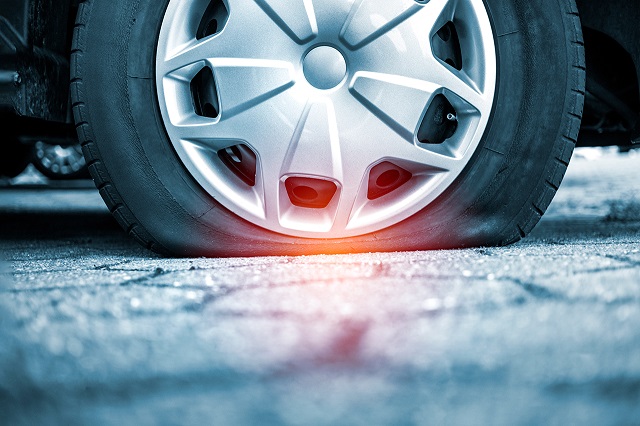A dead battery. Snow, ice and salt buildup. Frozen door locks. Many of winter’s harmful effects on your car are readily apparent. Others, however, you may not notice until it’s too late. Such is often the case for one of the most prevalent issues motorists must contend with during the colder months: low tire pressure.
There’s no way around it – your car tires will lose air pressure at a faster rate when the cold weather arrives. Here are the reasons behind low tire pressure in the winter, why underinflated tires cause a serious safety risk and ways to keep your tires solid when the weather is cold.
What Causes Low Tire Pressure in the Winter?
The simple answer to this question is cold temperatures. As you may remember from grade school science classes, when a substance is cooled, its molecules slow down and move closer together. In other words, the substance becomes compact and dense.
This same principle causes low tire pressure in the winter. As the temperature drops, the air molecules condense and exert less pressure on the walls of the tire.
As a general rule, a tire will lose one pound per square inch with every 10-degree drop in temperature. This is in addition to the one-to-two pounds per square inch (psi) tires typically lose each month from normal, everyday driving.
The Dangers of Low Tire Pressure
Low tire pressure can be expensive – it causes fuel inefficiency (which will cost you at the pump) and premature tread wearing (which means forking over money for a new set of tires). But driving with underinflated tires isn’t just a financial drain, it’s a serious safety hazard. Low tire pressure makes it more difficult to steer and stop, which can easily contribute to a crash. A worn-down tire is also more prone to punctures that will leave you with a flat.
Most notably on the safety front, low tire pressure can cause a blowout. When a tire is underinflated, more of its surface comes in contact with the road. This increases friction that, in turn, causes a buildup of heat. If the air inside a tire gets too hot, a portion of the rubber wall can pop loose. The sudden rupture causes an immediate and rapid loss of air. Blowouts are extremely dangerous as they can cause you to lose control of your vehicle and force other drivers to deal with a flying piece of debris.
When to Check Tire Pressure in Winter
The aforementioned dangers can all be prevented by taking the simple step of checking your tire pressure more often in the winter. Nowadays, most cars have tire-pressure monitoring systems that alert drivers via dashboard light when the tires are under inflated. But it’s best to keep your tires inflated rather than wait until they are underinflated.
You should be checking your tire pressure at least once a month throughout the year. During the winter, however, you’ll likely need to double the frequency. To get the most accurate reading, check your tire pressure using a high-quality air gauge in the morning or after the car has been idle for several hours. Tires and the air inside them will get hot when in use, causing the air to expand and pressure to increase. You need the tires to be cold to prevent a false reading. If the low-pressure light comes on when you start your car but goes away once you begin driving, you still have underinflated tires.
Compare the reading with the manufacturer’s tire pressure recommendation, which can be found in the owner’s manual and on the driver’s-side doorjamb. Once your tires are inflated to the recommended level, you’re good to go!
Winter is one season not to be trifled with. Learn how to prepare your car and stay safe on the road during the cold-weather months.
24 Thoughts on “What Causes Low Tire Pressure in Winter?”
Leave A Comment
Comments are subject to moderation and may or may not be published at the editor’s discretion. Only comments that are relevant to the article and add value to the Your AAA community will be considered. Comments may be edited for clarity and length.

















Very interesting? Does the physics also apply to footballs? For example, a football properly inflated in a warm environment will lose pressure if brought outside in a colder temperature? Maybe the NFL needs to read this article.
The “science” that controls this is something called Boyle’s law which states that the pressure of a gas changes with the temperature of that gas at a constant volume. The equation is PV=nRT ( as stated earlier) where n is just a number, so is R, P is pressure, V is volume (which is roughly constant in a properly inflated tire) and T is temperature in degrees KELVIN!. 70 degrees F is about 294 degrees kelvin, 20 Degrees F is about 266 degrees Kelvin and 0 degrees F is about 255 degrees Kelvin. And all of the comments about temperature of the air in your tires changing when you drive on them is of course true as well as the statements that air is 80% Nitrogen so all of the religious zealots who have convinced themselves that they are doing something smart by paying for “pure” nitrogen in their tires have nothing to fall back on for this discussion. The only possible justification for this is that the rubber inside your tires may degrade a bit slower if there is no oxygen in the air inflating them. Of course if you buy new tires every few years like I do this is irrelevant as well. If you want your tires to last 20 years this probably won’t do the trick either. So the pressure in tires will drop between 70 degrees F and 0 degrees F by about 13%. Smaller changes in temperature will have smaller variation and larger changes will be bigger. So being aware of your tire pressure in various seasonal as well as driving conditions is always a good idea. BTW 13% of 35 lbs of pressure is about 4.5 lbs. So a tire inflated to 35 lbs at 70 degrees F should show inflation of about 31 lbs at 0 degrees F. Not insignificant but not the end of the world either.
Another thing I discovered is that the spare tire has a sensor and it sets the dash light on. I put required amount + of air in the tires light still on. But garage says your spare in trunk is setting it off.
“This is in addition to the 1-2 psi tires typically lose each month from normal, everyday driving.” What? I have never found that to be the case in any car I have owned. I have had my current car for three years, so I guess I’m driving around on flat tires.
your article mentions “high quality tire pressure gauge”, are there any you would recommend? i have a few and all seem to vary quite a bit what they give for pressure. How do i know which one is accurate? where can i get a really good tire gauge?
thanks, Larry
Hi Larry, thanks for reaching out! Here’s a recommendation from our Car Doctor, John Paul: All tire gauges are okay but some are more accurate than others. Even digital gauges can vary +/- 3 percent. For a simple pencil-style gauge, Dill and Milton are quite good. For a round dial gauge, Milton is good, Slime products and Jayco have a liquid filled gauges, and for digital Accutire. I prefer the simple and inexpensive pencil gauges, no batteries to worry about and unless you are racing or checking high pressure touring bike tires they are a good all around choice.
Very good information,even though I don’t have a car anymore,I can pass on what I learned here today!
Good article on WHY cold air reduces tire pressure, but why wouldn’t the author mention the simple solution ?
Swap out the air in your tires for nitrogen!
Costco does this and many tire places offer it. Below zero temps won’t affect it. I haven’t touched my tires pressure in three years. Which is why commercial airliners use nitrogen in their tires. If they didn’t, you’d be landing on flat tires every flight.!
Air is almost 80% nitrogen. Nitrogen is affected by cold, slightly less than O2. Filling your tires with nitrogen is a waste of money. Try helium your car will float.
Doesn’t the air pressure rise due to the tire heating up from use? I would think the temperature while in use is not much different in the summer than in the winter.
Does filling tires with nitrogen help them to maintain pressure in cold weather?
Absolutely… 100%, correct
It will reduce variations in the pressure changes, but wont eliminate them.
There are also anti-corrosive benefits and slower degradtion of rubber with Nitrogen vs. Air.
Air is approximately 80% nitrogen. Nitrogen is still a gas and obeys the gas law: PV=nRT. Nitrogen (even dry nitrogen) will lose pressure at the same rate as air. Changing to pure nitrogen will not change the effect of temperature.
So true.
That is bull. you can test the tires cold, then after an hour on the highway they will read 4 or 6 psi higher, and may then be overinflated. especially for large tires on an SUV.
it is more important that the right pressure is had during sustained highway driving. so drive around for half an hour first, THEN check the pressure.
Sure – tires can lose air pressure in cold weather, I mean science and all. But the same science certainly does not pertain to footballs – especially those involving the Patriots. (You know – Deflategate and all.) (Hope everyone notes the sarcasm. 🙂 )
Is that you Tom?
Understand the science behind low air pressure when temps are colder and the need to periodically check tire pressure but I am curious whether the lower pressure in cold weather is just due to the car being parked and not moving. Therefore as soon as I start the car and drive the heating of the tires should restore the pressure back to normal assuming there is no leakage of air during the idle period?
Hi Richard, thanks for the question! Here’s what our Car Doctor John Paul has to say: Tires seep about 1 PSI per month in any weather but typically when the temperatures drops 10 degrees a tire will lose .8 of a pound. But realistically, you should check tire pressure in the temperature of the season. Properly inflated tires don’t vary tire pressure as much as under inflated tires. In the simplest of terms, the molecules of a properly inflated tire don’t move around as much and generate heat and expand.
My vehicle tire pressure indicator light kept coming on in the mornings, after frigid nights. Upon inspection by my mechanic, he determined that where the valve stems (and pressure sensors) were inserted into the wheel rims there was corrosion–probably due to the salt on the roads (to control ice in winter)–maybe there were also dissimilar metals in contact with each other. After replacing the pressure sensors on the whee rims, the problem ceased.
You have to fix all tire leaks including rim leaks and seals at the sensor / valve. Our rule of thumb is if its more than 7 or 8yrs old – replace it. Not worth putting a tire on and re-using the sensor only to have to replace it later (repeating the entire tire mounting/balance process – and it is not FREE). If sure you have no leaks – then it is likely old sensor. When they get to be 7, 8+ years old – the cold makes the voltage drop in the little button cell batteries inside and the sensor may drop out. When the tire heats up from a short amount of driving – the batteries warm up and the sensor comes alive and starts sending a signal again. I fix lots of TPMS problems that make other shops crazy.
I never liked those TPMS sensors. Big government telling me I’m not smart enough to check my tires on a regular basis.Just another large exspense to shut the TPMS warning light off on the dash when the sensors go bad on the battery dies in them.
Excellent article!